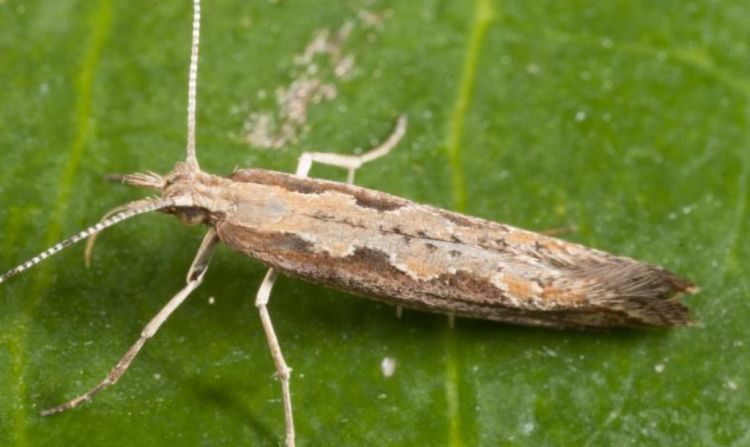Diamondback moth
The diamondback moth (DBM) (Plutella xylostella) is the most destructive insect pest of brassica crops across the world. It is a serious pest of canola and is found in all areas where cruciferous hosts exist.
Since 1993, brassica growers in Victoria have had difficulty in controlling the caterpillars of diamondback moth and have experienced insecticide control failures. In extreme cases, damaged crops have been ploughed in and produce has been unable to be sold.
Description
The adult is a small moth about 10 -12 mm long (Figure 1). The male moth is dark brown with 3 grey-brown uneven diamond-shaped patterns on its back. The female moth is tan coloured and its diamond patterns are less distinct than those of the male.

Eggs are pale yellow, oval and 0.5 mm long (Figure 2).
DBM larvae (caterpillars) are pale yellowish-green and tapered at both ends. They undergo 4 growth stages growing to approximately 12 mm in length (Figure 3).
Mature larvae spin fragile looking open mesh cocoons in which the pupa is clearly visible (Figure 4). Young pupa start off green and turn brown as they mature.



Feeding damage
DBM caterpillars feed on plant foliage, stems, flower heads and pods (Figure 5). Older caterpillars eat many small holes in the leaves of the host plants, often leaving the leaf epidermis (outermost layer of cells) intact, creating a see-through 'window effect’
Most damage is caused by the caterpillars tunnelling into the heads of plants such as cabbage and brussels sprouts and feeding on floral buds, flowers and pods. They also cause contamination of produce by pupating inside broccoli florets and cauliflower curds.
Heavily damaged plants can appear stunted and in most cases will die. Extensive feeding on reproductive plant parts will significantly reduce yields.
Brassica growers in Victoria have had difficulty in controlling the caterpillars of diamondback moth and have experienced insecticide control failures. In extreme cases, damaged crops have been ploughed in.

Hosts
The host plants of DBM include:
- brassica vegetable, forage and seed crops (e.g. bok choy, broccoli, cauliflower, cabbage, kohlrabi, turnip, brussel sprouts, mustard seed, rapeseed, canola)
- cruciferous weeds (e.g. wild mustard, radish and turnip; pepperweed, wintercress)
- ornamental crucifers (e.g. brightly coloured cabbage, kale and cauliflower)
Behaviour and life cycle
The adults are active at dusk and throughout the night. During the day, moths will fly from their resting places if plants are disturbed.
Female moths lay eggs singly or in small clusters on stems and both sides of the leaves. A female moth can lay more than 100 eggs during her lifetime. Eggs hatch after 4-6 days and the young caterpillars burrow into the leaf tissue.
The first, and some second growth-stage, caterpillars are leaf miners tunnelling inside the leaf. Subsequent growth stages feed on the underside of leaves or tunnel into the plant. Caterpillars that are disturbed from feeding will wriggle backwards rapidly across the leaf surface and may drop off the plant where it will hang suspended on a silken thread.
The time taken to complete the life cycle depends on temperature. In summer in Victoria, the life cycle of the moth will be completed in about a month. During winter, the pest develops much more slowly and causes little damage. As the temperature increases in spring and summer, the moth goes through its life cycle more quickly and pest numbers build up.
In one year, the moth can complete 6 to 7 life cycles. Generations overlap throughout the warmer months of the year.
Distribution
DBM has an extensive global distribution and is considered to be the most universally distributed of all moth species. Although present in every state in Australia they are most common in the southern states, and most abundant in canola crops during spring.
Spread
DBM are weak flyers and will only move up to 35 m within a crop. Adults can disperse long distances (hundreds of kms) by wind currents. Immature stages can be distributed by being transported on clothing, packaging, vehicles, plants and plant material.
Control
Chemical control
Reliance on chemicals as a control measure for the diamondback moth has resulted in the moth developing resistance to many insecticides. Resistance to synthetic pyrethroid insecticides has been detected in populations of diamondback moth in all Australian states.
It is difficult to get insecticide contact with the diamondback caterpillar because its feeding sites are under leaves and within the plant tissue. This inaccessibility, and known insecticide resistance issues, means that a single chemical solution is not possible.
Biological and cultural control
Management of diamondback moth requires an integrated approach.
Biological control agents such as predators and wasp parasitoids of this pest are present in crops in low numbers and can provide some level of control.
The following integrated pest management methods should be used to control the pest:
- Start off with clean, healthy transplants.
- Understand the life cycle of the moth and recognise the caterpillar stages.
- Check brassica crops at least once a week during the warmer months of the year. Small caterpillars (dark head stage) are easiest to control.
- Control summer and autumn weeds (wild radish and Lincoln weed) in order to reduce survival of larval populations.
Image Credits
Figure 1. Andrew Weeks, CESAR
Figure 2. Whitney Cranshaw, Colorado State University, Bugwood.org
Figure 3 & 4. David Cappaert, Bugwood.org
Figure 5. Alton N. Sparks, Jr. University of Georgia, Bugwood.org.
More information
Reporting an unusual plant insect pest or disease
Report any unusual plant pest or disease immediately using our online reporting form or by calling the Exotic Plant Pest Hotline on 1800 084 881. Early reporting increases the chance of effective control and eradication.
Please take multiple good quality photos of the pests or damage to include in your report where possible, as this is essential for rapid pest and disease diagnosis and response.
Your report will be responded to by an experienced staff member, who may seek more information about the detection and explain next steps.
Report online